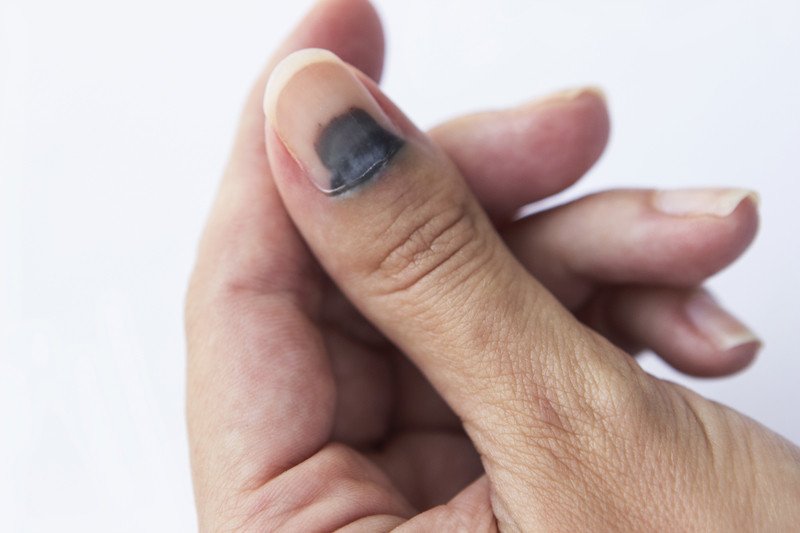Nail trauma
Medically reviewed by Drugs.com. Last updated on May 7, 2024.
What is nail trauma?

A fingernail or toenail can be injured by a blow to the nail or by closing the finger or toe in a door or drawer. This kind of trauma commonly results in blood under the nail, a condition called subungual hematoma. Nails also can be accidentally torn or split, or a splinter can get under the nail.
Repeated trauma to toenails, caused by ill-fitting shoes, can lead to deformities in the nails. The deformities may resemble a fungal infection; nails can be thickened or discolored and can lift away from the nail bed, which causes cosmetic concerns.
Habits such as nail biting and cuticle biting also can cause trauma to the nails. Nail biting is a main cause of acute paronychia, a type of infection in which bacteria get underneath the tissue at the side of the nail and cause swelling and irritation. Repetitive picking at your thumb's nail and cuticle with your index finger can produce a line of horizontal hatch marks in the middle of the nail. In extreme cases, the nail can split.
Symptoms of nail trauma
A subungual hematoma appears dark red under the nail. The finger or toe is painful and may throb.
|
|
Other nail trauma also may be painful, and the nail can split, crack, or lift away from the nail bed.
Diagnosing nail trauma
Your doctor can examine any nail trauma to decide what course of action is best. Depending on the trauma, your doctor may want to have X-rays taken.
Expected duration of nail trauma
Nail injuries can be noticeable until the damaged nail grows out. Fingernails usually regrow completely in about two months. Toenails take about four months. If injury includes the base of the nail, some cosmetic changes may be permanent.
Preventing nail trauma
To help prevent nail trauma:
- Wear properly sized shoes. Many people wear shoes that are too small, which can lead to many foot problems, including toenail trauma.
- Keep your fingernails trimmed and do not bite your nails or cuticles.
Treating nail trauma
Treatment for a subungual hematoma is aimed at relieving pressure by draining the blood trapped under the nail. For a small hematoma, you can heat a needle or the end of a paper clip until it is red-hot. Using gentle pressure, the hot tip can penetrate the nail, creating a small hole through which blood can drain. The nail may remain discolored after the procedure.
Some people do not feel comfortable doing this at home. Your physician can provide the same treatment in his or her office using a sterile blade or needle. If blood takes up more than half of the area under your nail, a physician should evaluate the nail. Occasionally, the nail may need to be removed so a deep tear can be repaired with stitches.
If the nail is torn or jagged, you should trim it to avoid snagging it on things and further injuring it.
If your nail lifts completely off the nail bed, it may be most comfortable initially to replace the nail and hold it in place with a bandage. Nails will not reattach themselves to the nail bed after they have separated from it, but in most cases new nail will slowly regrow.
When to call a professional
If blood under the nail occupies more than half of the nail area, a physician should evaluate the finger because it could signify an underlying bone fracture or tissue tear. Your doctor also should evaluate bleeding under the nail that is not caused by trauma.
If you experience a nail injury, make sure that your tetanus vaccination is up to date.
Prognosis
The outlook is excellent. If the trauma to the nail injures the nail matrix (the tissue inside the cuticle at the base of the nail where new nail is formed), a ridge or split can develop. If the matrix heals normally, this deformity eventually will disappear as the nail regrows.
Additional info
American Academy of Dermatology
https://www.aad.org/
Further information
Always consult your healthcare provider to ensure the information displayed on this page applies to your personal circumstances.

